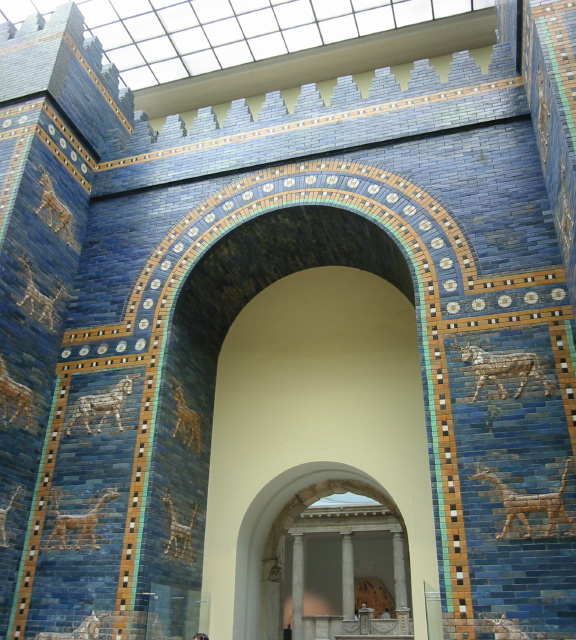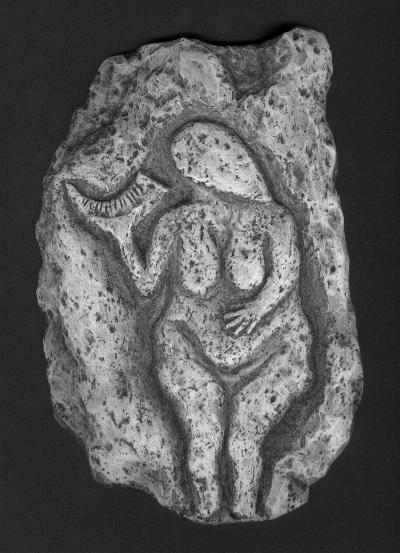Paleolithic Art (The Birth of Art)
1. Paleolithic Art was produced from about 32,000 to 11,000 years ago.
2. Most early art are found in northern France and northern Spain.
3. What kinds of art were created during this time?
Only two kinds were created. Art was either portable or stationary, and both of these art forms were limited in scope.
Portable art was necessarily small (in order to be portable) and mainly consisted of either figurines or decorated objects. These things were carved (from stone, bone or antler) or modeled with clay. We refer to most of the portable art from this time as figurative, meaning it actually depicted something recognizable, whether animal or human in form. The figurines are often referred to by the collective name of "Venus", as they are unmistakably females of child-bearing build.
Stationary art was just that: it didn't move. The best examples exist in (now famous) cave paintings in western Europe, created during the Paleolithic period. Paints were manufactured from combinations of minerals, ochres, burnt bone meal and charcoal mixed into mediums of water, blood, animal fats and tree saps. We've guessed (and it's only a guess) that these paintings served some form of ritualistic or magical purpose, as they are located far from the mouths of caves where everyday life took place. Cave paintings contain far more non-figurative art, meaning many elements are symbolic rather than realistic. The clear exception, here, is in the depiction of animals, which are vividly realistic (humans, on the other hand, are either completely absent or stick figures).
4. What are the key characteristics of Paleolithic art?
Paleolithic art:
a. Concerned itself with either food (hunting scenes, animal carvings) or fertility (Venus figurines). Its predominant theme was animals.
b. Is considered to be an attempt, by Stone Age peoples, to gain some sort of control over their environment, whether by magic or ritual.
c. Represents a giant leap in human cognition: abstract thinking.
5. Examples:
a. Makapansgat pebble
The Makapansgat pebble or the pebble of many faces, is a 260-gram reddish jasperite cobble with natural chipping and wear patterns that make it look like a crude rendition of a human face and is considered the first manuport (a manuport is a natural object which has been moved from its original context by human agency but otherwise remains unmodified). Though it is definitely not a manufactured object, it has been suggested that some australopithecine (probably refers to the ancestors of the human kind and further information can be found on Wikipedia) or possibly another hominid (any member of the biological family that includes humans, chimpanzees, gorillas, and orangutans), recognized it as a symbolic face and brought it back to camp. If so, it may be a candidate for the earliest example of symbolic thinking or aesthetic sense in the human heritage. The Makapansgat cobble is the oldest known object of this kind in the world, and for more than one half of the duration of human history it remains alone on our extremely fragmentary archaeological record.
The teacher Wilfred I. Eizman found it in Makapansgat in the Makapansgat valley (or Makapan Valley), South Africa in 1925. Almost 50 years later, Raymond Dart was the first to describe it in 1974.
b. Apollo 11 cave (25,500–23,500 B.C.)
Africa's oldest known paintings, small stone plaquettes with images of animals, were excavated from a rock shelter in southern Namibia in 1969 when the first spacecraft (Apollo 11) landed on the moon, hence its name. The date derived from charcoal deposits found in the layers of sediment surrounding the plaquettes. They may never have formed a part of the shelter wall but, rather, have been loose stones on which paintings were made. Now located in State Museum of Namibia.
c. Human with feline head (The Lion Lady)
A lion headed figure, first called the Lion man (German: Löwenmensch), then the Lion Lady (German: Löwenfrau), is a sculpture made of mammoth ivory. It is the oldest known animal-shaped sculpture in the world and one of the oldest known sculptures in general. The sculpture has also been interpreted as anthropomorphic, giving human characteristics to an animal, although it may have represented a deity. The figurine was determined to be about 32,000 years old.
Its pieces were found in 1939 in Stadel cave in Hohlenstein Mountain in the Lone valley (Germany). Due to the beginning of the Second World War, it was forgotten and only rediscovered thirty years later. The first reconstruction revealed a humanoid figurine without head. During 1997 through 1998 additional pieces of the Sculpture were discovered and the head was reassembled and restored. Today it is pieced together from more than 200 tiny pieces. This 'venus' may be an attempt to capture the power of the lion.
The sculpture is 29.6 cm (11.7 inches) in height, 5.6 cm wide and 5.9 cm thick. It was carved out of mammoth ivory using a flint stone knife.
Originally, the figure was classified as male by Professor Hahn. From examination of some additional parts of the sculpture found later, Professor Schmidt then determined that the figure was female (a lioness) and called it Lowenfrau (lionlady). Both interpretations lack scientific evidence however, there is no mane (indicating a male) on sculpture. Recently it is more often called a lion headed figurine, rather than the probably-incorrect title, lion man.
The sculpture can be seen in the Ulmer Museum in Ulm, Germany.
d. Woman holding bison horn (Venus of Laussel)
The Venus of Laussel is a 1.5 foot high painted limestone of a nude female figure, painted with red ochre. It is approximately 25,000 years old. It if found in the Dordogne Valley in France.The figure holds a bison horn in one hand, which has 13 notches. According to some researchers, this may symbolize the number of moons or the number of menstrual cycles in one year. She has her hand on her abdomen (or womb), with large breasts and vulva. There is a "Y" on her thigh and her faceless head is turned toward the horn.The figure was rediscovered in 1911 by J. G. Lalanne, a physician. It was found in a limestone rock shelter from Laussel, Dordogne, France. It is now in the Musée d'Aquitaine, in Bordeaux, France.
e. Two Bison
The sculpture of the two bison or the bison bull and the cow is found at Le Tuc d'Audoubert, Ariege. The sculptures are 63 and 61 cm long respectively from left to right. They probably cracked shortly after being made, as the clay dried. Each bison is approximately two feet long. (15,000 – 10, 000 BC)
f. Altamira cave paintings
Paintings of bison on a cave in Spain called Altamira. It was painted about 14,000 years ago (around 12000-11000 b.c.). 13,000 years ago a rock-slide closed the entrance and until 1879 no one ever went in there again. A hole opened up in the ground and a little girl ventured down like Alice in Wonderland. She ran to get her father, an amateur archaeologist. When he told the world what his daughter had discovered, no one would believe him. No prehistoric paintings like those had ever been seen. And they looked suspiciously modern. After a long debate the experts finally withdrew their objections and declared the paintings genuine. After that, people began to visit the Altamira cave in greater and greater numbers until the authorities decided to close it because the paintings showed damage from the moisture and heat that rose from the visitors. Each bison is approximately five feet long.
h. Spotted horses and negative hand imprints (22,000 BC)
This wall painting is discovered in the cave at Pech-Merle, Lot, France. It is painted with natural pigments. Some people believe the horse was created because the shape of the stone already resembled a horse. The handprints might have been signatures. It is approximately 11 feet 2 inches.
i. The hall of the bulls
The Great Hall of the Bulls covers about 20 meters and it is composed of three groups of animals: horses, bulls and stags.
The Great Hall of the Bulls cave painting begins with a unicorn-like figure who seems to be chasing a herd of horses. This is linked with a large, partially drawn bull towards the back of the hall. On the opposite side, a similar illustration made up of three large wild oxen (now extinct) balances this composition. The meeting point of these two groupings is a group of small stags painted in ochre.
The few symbols are limited to isolated or grouped dots, often black, and to variously colored dashes. The color black dominates the figurative works: only the group of stags, three bovines and four horses, of which three are incomplete, are colored red.
The Great Hall of the Bulls is located in Lascaux, France. It is dated back to 15000 to 13000 b.c.
The largest bull is approximately 11 feet 6 inches
j. Rhinoceros, Wounded Man and Disemboweled Bison (The Shaft of the Dead Man/Well Scene)
Well Scene is about the confrontation between a man and a bison while a rhinoceros flees on the left. Nearby is a bird figure on a stick, whose head interestingly resembles that of the man. This painting is found in a cave in Lascaux, Dordogne, France. It is dated back to 15000 to 13000 BC. The bison is approximately 3 feet 8 inches. It is described as the world’s oldest painting.
k. Stonehenge
Stonehenge is a prehistoric monument located in the English county of Wiltshire. Archaeologists had believed that the iconic stone monument was erected around 2500 BC. Stonehenge was produced by a culture with no written language. There is little or no direct evidence for the construction techniques used by the Stonehenge builders.
References
Paleolithic Art
www.wadsworth.com/art_d/templates/student_resources/0155050907_kleiner/studyguide/ch01/ch01_1.html
http://www.huntfor.com/arthistory/prehistoric/paleolithic.htm
http://arthistory.about.com/cs/arthistory10one/a/paleolithic.htm
makapansgat
http://mc2.vicnet.net.au/home/portable/web/manuport.html
http://en.wikipedia.org/wiki/Makapansgat_pebble
apollo 11 cave
http://www.metmuseum.org/toah/hd/apol/hd_apol.htm
http://www.africanrockart.org/rockafrica/apollo.html
http://arthistorypart1.blogspot.com/2008/01/prehistoric-rock-art-in-africa-apollo.html
human with feline head
http://www.donsmaps.com/lionlady.html
http://en.wikipedia.org/wiki/Lion_man
woman holding bison horn
http://en.wikipedia.org/wiki/Venus_of_Laussel
http://www.donaldmiller.com/venus_of_laussel.htm
http://www.wadsworth.com/art_d/templates/student_resources/0155083155_gardner/chapterstudyguide/ch01-02.html
two bison
http://www.donsmaps.com/cavepaintings3.html
altamira cave paintings
http://www.humanities-interactive.org/ancient/iceage/ex038_07a.html
http://100swallows.wordpress.com/category/spain/
running of the bulls
http://www.sacred-destinations.com/france/lascaux-caves.htm
Stonehenge
http://www.britannia.com/history/h7.html
http://en.wikipedia.org/wiki/Stonehenge


![The Great Pyramid of Khufu, flanked by those of his sons, Khafre and Menkaure, Giza, Egypt, …[Credits : Kenneth Garrett—National Geographic/Getty Images]](http://media-2.web.britannica.com/eb-media/31/83831-004-4AE615AA.jpg)













